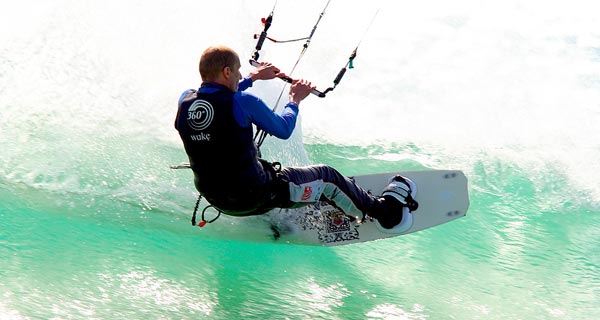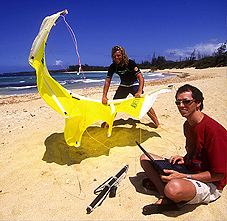The History of Kiteboarding and Launch of a New Sport
BY
I’m sure we can all agree that kiteboarding has to be one of the most dynamic and exhilarating sports on the planet. In fact, even people who have never had the pleasure of kiteboarding themselves, are drawn to the sport and fascinated by the speed, insanely high jumps, dizzying combinations of tricks, or the purity of riding the waves like surfers. But have you ever wondered where kiteboarding came from, who invented the inflatable kite, or how we got to where we are today as kiteboarders?

There are of course a number of great resources documenting the history of kiteboarding or kitesurfing, but we thought we’d summarise the highlights for you, so you can get back to doing what you live for… kiteboarding. And if you’d rather get body slammed into a mine field of sea urchins on an exposed reef than read an article on the history of kiteboarding, then feel free to skip straight to the video below, which is a humorous and very entertaining look at how it all started.
Seriously though, we can’t thank the producers, Josh Kendrick and Dan Connely enough for this brilliant tribute to kiteboarding, which comes packed with interviews with all the great pioneers of kitesurfing, and is what inspired us to write this article in the first place. It’s 55min long, so if you don’t have time for that, we’ve also included a 6 min video, Short Kiteboarding History by Susi Maiand Robby Naish.
Who Invented Kiteboarding
The story of kiteboarding will vary slightly depending on who you speak to. The Chinese for example are credited with using kites as a means of propulsion as far back as the 13th century. In the 1800’s George Pocock used kites to propel carts on land and ships on the water, making use of a 4-line control system similar to what we use today. And in 1903, aviation pioneer Samuel Cody developed “man-lifting kites” and succeeded in crossing the English Channel in a small collapsible canvas boat powered by a kite. You can read more about the early history of kites here.

Bruno Legaignoux
But the pioneers of kiteboarding as we know it today are the Legaignoux brothers, Dominique and Bruno Legaignoux from Breton, France, who are credited with inventing the first inflatable kite. They first started experimenting with kites in 1984, and in 1985 demonstrated a prototype at the Brest International Speed Week and filed their first patent.
However, they weren’t alone… parallel to this, and all the way across the ocean in Oregon, USA, Cory Roeseler was developing his Kiteski together with his dad, Bill Roeseler, a Boeing aerodynamicist. Cory’s KiteSki became commercially available in 1994, could go upwind and had a rudimentary water re-launch system. In the late 1990s, the Kiteski evolved into a single board similar to a surfboard. The video (around minute 6:40) shows just how instrumental Cory was in the development of kiteboarding.

Cory Roeseler
Development of Kiteboarding as a Sport
In 1997 the Legaignoux brothers partnered with Neil Pryde to produce small numbers of kites, which they then sold under the brand name Wipika. These kites had preformed inflatable tubes and a simple bridle system, both of which greatly assisted their water re-launch ability. Bruno Legaignoux has continued to improve his kite designs, and went on to invent the bow kite design a few years ago which has been licensed to many kite manufacturers, and has become quite popular in modern day kitesurfing. Learn more about the various kite designs here.

First Bow Kite | Image Courtesy of Ocean2Air
In 1998 Don Montague and Robby Naish requested a licence from Bruno, and as part of their agreement, Don Montague developed software which enabled them to design great kites in a fraction of the time. This was one of the defining moments of the sport.
The birth of kiteboarding as a mainstream sport really began in 1998 when Joe Keuhl organised the first kiteboarding event, which took place on Maui in Hawaii. The competition was jokingly dubbed the kitesurfing world championships and all the big names in kiteboarding were there (25 of them). Flash Austin won the competition.
Of course, learning to kitesurf in those days was treacherous. There were no instructors to learn from, no trainer kites, and nobody had figured out that they should launch the kite at the edge of the window yet. It really was the wild, Wild West back then…
One of the unique aspects of kiteboarding is that it developed in a number of different directions all roughly around the same time… on the one hand you had the likes of Robby Naish and Flash Austin boosting massive jumps, while guys like Lou Wainman and Elliot Leboe were pioneering the wakestyle side of kiteboarding. And now, largely thanks to the KSP World Pro Kite Tour, we’re getting back to our surfing roots with strapless wave kitesurfing.

Originally the terms kiteboarding and kitesurfing really meant the same thing, however, in recent years there’s been a push to distinguish the two as different disciplines. Kiteboarding refers to anything that isn’t wave riding, so this would include freestyle, wakestyle, speed and racing, while riding waves with a kite would be kitesurfing. This trend really gained momentum when the KSP tour launched in 2011 with the One Eye Pro in Mauritius.
Video: Upwind Launch of a Sport
If you want to hear how it all began from the pioneers and influencers themselves, we highly recommend watching this video…
If you are reading this in an email or RSS reader, click here to watch the video.
The Future of Kiteboarding
The future is definitely looking bright for kiteboarding and kitesurfing. We’ve got two pro tours, with the PKRA covering freestyle and the KSP geared purely towards wave riding. We’ve got speed and course racing world championships. Kite gear is evolving at an incredible pace, with kites and bar systems becoming safer and more efficient. Kite schools with qualified instructors can be found all around the world, and more youngsters and girls are getting into kiteboarding, which is great for any new sport. On top of that, kiteboarding almost became an Olympic sport last year, and while we didn’t make it for the 2016 Games in the end, we’re confident that kiteboarding in the Olympics is in the not too distant future.
Short Kiteboarding History by Susi Mai & Robby Naish
If you are reading this in an email or RSS reader, click here to watch the video.
We hope you’ve enjoyed this little walk down memory lane. If you think we’ve missed anything important, please do let us know in the comments below and we’ll update the article accordingly. And if you enjoyed this article or the videos, please do share it with your friends.
Note: The first and last image are courtesy of Neil Egerton Photography.
FAIR-USE COPYRIGHT DISCLAIMER
* Copyright Disclaimer Under Section 107 of the Copyright Act 1976, allowance is made for "fair use" for purposes such as criticism, commenting, news reporting, teaching, scholarship, and research. Fair use is a use permitted by copyright statute that might otherwise be infringing. Non-profit, educational or personal use tips the balance in favor of fair use.
1)This video has no negative impact on the original works (It would actually be positive for them)
2)This video is also for teaching purposes.
3)It is not transformative in nature.
4)I only used bits and pieces of videos to get the point across where necessary.
BUDDY HUGGINS does not own the rights to these video clips. They have, in accordance with fair use, been repurposed with the intent of educating and inspiring others. However, if any content owners would like their images removed, please contact us by email at buddyhuggis@gmail.com
///////

No comments:
Post a Comment